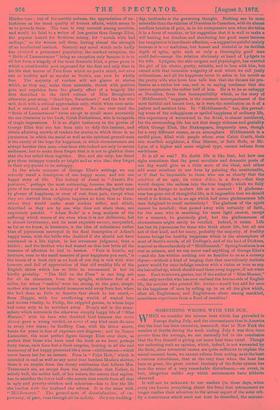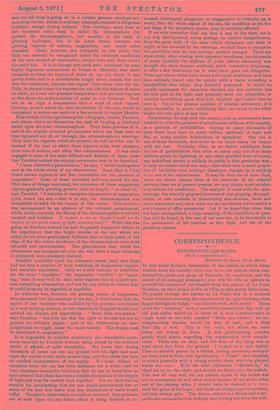SOMETHING WRONG WITH THE . SUN.
WHEN we consider the intense heat which has prevailed in Europe during July, and the circumstance that in America also the heat has been excessive, insomuch that in New York the number of deaths during the week ending July 6 was three times greater than the average, we are naturally led to the conclusion that the Sun himself is giving out more heat than usual. Though not endorsing such an opinion, which, indeed, is not warranted by the facts, since terrestrial causes are quite sufficient to explain the recent unusual heats, we cannot refrain from noting, as at theleast a curious coincidence, that at the very time when the heat has been so great, the great central luminary of the Solar system has been the scene of a very remarkable disturbance,—an event, in fact, altogether unlike any which astronomers have hitherto observed.
It will not be unknown to our readers (in these days, when every one knows everything about the Sun) that astronomers no longer confine their attention to the actual aspect of the solar orb. By a contrivance which need not here be described, the astrono-
mer can tell what is going on in a certain gaseous envelope sur- rounding the sun, which to ordinary telescopic research is altogether invisible, except during eclipses. This envelope, some four or five thousand miles deep, is called the chromosphere (by -purists, the chromatosphere), and consists in the main of glowing hydrogen, but in its lower strata contains the ,glowing vapours of sodium, magnesium, and many other elements. These, however, are ordinarily so low down that -they can scarcely be recognised under the ordinary conditions of the new method of observation, except here and there round -the sun's disc. It is as though our earth were examined by some • highly ingenious astronomers in Venus or Mercury, who could -recognise at times the vapour of water in our air, where it rose pretty freely and to a considerable height above oceans, but not over the continents, because less vapour there arose into. the air. Only, in the sun's case the vapours are not, like the vapour of water -on earth, at a cool and pleasant temperature, but are such vapours -as rise above the molten surface of metal in our furnaces. They -are at so high a temperature that a wind of such vapour. blowing, as such winds do, over the surface of the sun, would be .competent to reduce our earth in a few seconds to vapour likewise.
Now certain Italian spectroscopists—Respighi, Secchi, Tacchini, and others—have set themselves the task of keeping a continual -watch upon the solar chromatosphere. They draw pictures of it, and of the mighty coloured prominences which are from time to time upreared out of, or through, the chromatospheric envelope. They note the vapours which are present, as well as what can be 'learned of the heat at which these vapours exist, their pressure, 'their rate of motion, and other like circumstances. It was while engaged in some of the more difficult and delicate of these tasks -that Tacchini noticed the strange occurrence now to be described.
" I have observed a phenomenon," he says, " which is altogether new in the whole series of my observations. Since May 6, I had 'found certain regions in the Sun remarkable for the presence of magnesium." Some of these extended half-way round the sun. 'This state of things continued, the extension of these magnesium -regions gradually growing greater, until at length, " on June 18," says Tacchini, "I was able to recognise the presence of magnesium -quite round the sun,—that is to say, the chromatosphere was -completely invaded by the vapour of this metal. This ebullition was accompanied by an absence of the coloured prominences, while, on the contrary, the flames of the chromatosphere were very marked and brilliant. It seemed to me as though I could see the surface of our great source of light renewing itself." While this was going on Tacchini noticed (as had frequently happened before in his experience) that the bright streaks on the sun which are called/act/Ix were particularly brilliant close to those parts of the edge of the disc where the flames of the chromatosphere were most 'splendid and characteristic. The granulations also, which the astronomer can recognize all over the sun, when a large telescope is employed, were unusually distinct.
Tacchini concludes (and the inference seems just) that there liad not been a number of local eruptions of magnesium vapour, but complete expulsions. Only we would venture to substitute -for the word " expulsion " the expression " outflow " or " upris- ing," since it may well be that these vapours rise by a quiet pro- cess resembling evaporation, and not by any action so violent that it could properly be regarded as expulsive.
In whittever way, however, the glowing vapour of magnesium -thus streamed into the envelope of the sun, it would seem that the aspect of our luminary was modified by the process,—not indeed In a very striking manner, or our observers in England would have noticed the change, yet appreciably. " More than one person," :says Tacchini, " has told me that the light of the sun has not at .present its ordinary aspect ; and at the Observatory we have judged that we might make the same remark. The change must be attributed to magnesium."
It is impossible to consider attentively the remarkable occur- .'rence recorded by Tacchini without being struck by the evidence 'which it affords of solar mutability. We know that during
'thousands of years our sun has poured forth his light and heat Avon the worlds which circle around him, and that there has been ,no marked intermittence of the supply. We hear, indeed, of
'occasions when the sun has been darkened for a while ; and we have abundant reasons for believing that he has at times been so spot-covered that there has been a notable diminution of the supply of light and heat for several days together. Yet we have had no -reasons for anticipating that our sun might permanently lose so much of his heat and lustre that the inhabitants of earth would .suffer. Tacchini's observation reminds us, however, that processes -are at work upon the sun which admit of being checked or in- creased, interrupted altogether or exaggerated so violently (as it were), that the whole aspect of the sun, his condition as the fire and lamp of the planetary system, may be seriously affected.
If we only remember that our Sun is one of the stars, not in any way distinguished, unless perhaps by relative insignificance, from the great bulk of the stars which illuminate our skies at night, or are revealed by the telescope, we shall learn to recognise the possibility that he may undergo marked changes. There are stars which, after shining with apparent steadiness, for thousands of years (possibly for millions of years before astronomy was thought of), have become suddenly much reduced in brightness, or after a few flickerings (as it were) have gone out altogether. There are others which have shone with equal steadiness, and have then suddenly blazed out for awhile with a lustre exceeding a hundredfold that which they formerly possessed. It would be equally unpleasant for ourselves whether the sun suddenly lost the best part of his light, and presently went out altogether, or whether he suddenly grew fifty-fold brighter and hotter than he now is. Yet in the present position of sidereal astronomy, it is quite impossible to assert confidently that one event or the other might not take place at any time.
Fortunately, we may view this matter (just as astronomers have learned to view the prospect of mischievous collisions with comets), as a question of probabilities. Among so many thousands of stars there have been so many sudden outbursts of light and fire, so many sudden defalcations of splendour. Our 81111 is one of those thousands, and so far as we know takes his chance with the rest. Precisely, then, as we derive confidence from the law of probabilities, that since so many only out of so many millions perish by lightning or any other specified form of injury, any individual person is unlikely to perish in that particular way ; so may we reason about our sun,—that since only a small propor- tion of his fellow suns undergo disastrous changes, he is unlikely to be one of the unfortunates. It may be that one of these days, when we obtain clearer ideas of the structure of the sidereal universe than we at present possess, we may obtain more satisfac- tory reasons for confidence. The analysis of stars with the spec- troscope, the recently proposed processes of star-gauging, the appli- cation of new methods of determining star-motions, these and other researches may show what are the conditions which render a sun's tenure of office precarious. Let it be hoped that when this has been accomplished, a large majority of the conditions in ques- tion will be found, in the case of our own sun, to be favourable to the permanence of his position as fire, light, and life of the planetary system.



































 Previous page
Previous page